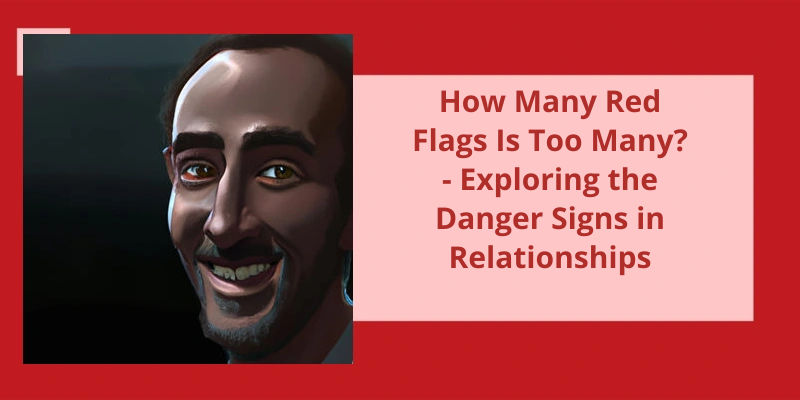Finding love can be a thrilling, yet nerve-wracking experience. As we navigate the dating scene, we may come across potential partners who exhibit certain behaviors or traits that give us pause. These warning signs, commonly referred to as "red flags," can range from minor concerns to major deal breakers. But how many red flags should we tolerate before calling it quits? It's a question that many of us have asked ourselves at one point or another. According to research conducted by dating app Badoo, the majority of singletons are willing to overlook a few red flags in a partner. However, there seems to be a tipping point, with two red flags being the limit for many before ending a relationship. But is this threshold too low, or are we right to be cautious when it comes to matters of the heart? Let's explore this question in more depth.
Is It Okay to Have Red Flags in a Relationship?
The reality is that red flags are more common than wed like to believe in relationships, and they can signify a wide range of issues that can eventually lead to the end of a relationship. As such, it’s important to pay attention to these warning signs and not sweep them under the rug.
Some common red flags may include a lack of communication, dishonesty, disrespect, and controlling behavior, among others. At first, these traits may seem manageable or even endearing, but in the long run, they can be indicative of much larger issues.
Ignoring red flags can ultimately lead to a harmful and toxic relationship, and it can be difficult to recover from such damage. It’s important to be honest with yourself and your partner about any concerns you may have, and to work through them together in a positive and healthy way.
If you feel that you can work through the issues and ultimately come out stronger on the other side, then it may be worth sticking it out. However, if the red flags are too severe or you feel that your partner is unwilling to change, then it may be time to walk away.
They can signify larger issues that can ultimately be harmful to the relationship. Pay attention to warning signs and don’t be afraid to speak up and work through issues together. Ultimately, the decision to stay or leave is up to you, but it’s important to prioritize your own emotional well-being.
Ignoring warning signs can lead to devastating consequences in various aspects of life. Whether it’s a business deal, personal relationship, or health issue, red flags shouldn’t be ignored. It’s essential to pay attention to these indicators, as they could be a sign of a potential problem or danger. Experts agree that it’s crucial to interpret the signs and take appropriate action to avoid the negative impact of ignoring red flags. Dr. Behr emphasizes the importance of acknowledging and addressing any red flags that come our way.
Should I Ignore Red Flags?
“Thats how we can tell that something isn’t right or that we need to pay closer attention.”. Ignoring red flags can result in serious consequences and can put you in harms way emotionally, mentally, or even physically. For instance, if you were to notice a red flag in a potential romantic partner, but ignore it, the consequences could be catastrophic. You could end up in an abusive relationship or with someone who doesn’t have your best interests at heart.
The same applies to other areas of your life. If you notice a red flag at work, it could be an indication that your job is in jeopardy or that you need to speak to someone in higher management. These are valuable tools that help you navigate through life, and ignoring them could be detrimental to your decision-making skills.
This is because your mind is aware of the red flag and will continue to remind you of it until you address the situation. The more you ignore it, the more it will pile up and become harder to handle. Therefore, it’s essential to listen to your mind and address any red flags that come up.
How to Identify Red Flags in Different Areas of Your Life (Career, Friendships, Family, Etc.)
- Pay attention to your gut feelings. If something doesn’t feel right, it probably isn’t.
- Observe patterns of behavior in others. Are they consistently unreliable or dishonest?
- Be wary of people who consistently put their needs above others.
- Pay attention to how people make you feel. Are you consistently drained or stressed around them?
- Notice if people play the victim consistently or fail to take responsibility for their actions.
- Be mindful of people who gossip or trash-talk others behind their backs.
- Pay attention to how people react when you set boundaries or express your needs.
- Be cautious of people who try to control or manipulate you.
- Observe if people have a track record of not following through on commitments and promises.
- Be cautious of people who consistently prioritize material possessions over relationships or personal values.
Understanding red flags and triggers is essential when it comes to managing one’s emotional and mental health. A trigger can cause individuals to experience heightened anxiety or even PTSD symptoms, and red flags can warn us of potential danger in a particular situation. In this article, we will explore how to identify and manage both red flags and triggers effectively.
What Are Red Flags and Triggers?
In the mental health community, triggers and red flags are both terms that are used frequently. They both refer to important warning signs that can help individuals identify and navigate difficult or potentially dangerous situations. Both are valuable tools for protecting ones mental and emotional well-being.
Triggers can be incredibly powerful and can elicit a wide range of emotions such as fear, anxiety, anger, sadness, or more. They can be near-constant, such as the daily reminders of a loss, or can come out of nowhere like unexpected sounds or sensations. The experience of being triggered can often feel incredibly overwhelming, and it can be difficult to manage these emotional reactions on your own.
Red flags, on the other hand, are warning signs that something isn’t right. They can be associated with situations, environments, or individuals, but all of them serve as a signal of danger or a potential threat to ones safety or well-being. For example, a person might feel uncomfortable or uneasy in a particular place, or they may notice alarming behaviors in others that signal potential danger.
Overall, being able to identify triggers and red flags is an important part of cultivating mental and emotional well-being. By recognizing these warning signs and taking appropriate action to address them, individuals can protect themselves from potential harm and navigate their emotions and experiences more effectively. This can lead to a greater sense of safety, security, and resilience in the face of adversity.
Identifying Red Flags in Relationships and How to Respond
- Verbal or physical abuse
- Controlling behavior
- Lack of trust or jealousy
- Dishonesty or lying
- Isolation from friends and family
- Disrespectful or dismissive behavior
- Frequent arguments or disagreements
- Unwillingness to compromise or communicate effectively
- Lack of empathy or understanding
- Unfaithfulness or cheating
Source: Trigger or red flag? | Emotionally Naked Blog
Understanding what red flags mean is important as it can be a warning of potential danger or a symbol of political revolution. Red flags are significant indicators that shouldn’t be ignored, as they can provide valuable information and insight into a situation or circumstance. By recognizing and paying attention to these warning signs, you can avoid potential risks and make informed decisions.
What Are Some Red Flags Meaning?
Red flags are signs or warning signals that something isn’t quite right. They can be observed in a variety of settings, such as professional, personal, or social relationships. Recognizing red flags is an important skill to have, as it can help you avoid potential problems or negative consequences.
For instance, a partner who frequently puts you down or belittles you, tries to isolate you from friends and family, or constantly checks your phone or social media accounts may be displaying red flag behavior.
In the workplace, red flags might signal workplace bullying, discrimination, or unethical behavior. For example, if your boss or coworker is constantly criticizing or sabotaging your work, spreading rumors about you, or engaging in discriminatory behavior towards certain employees, these are all red flags that shouldn’t be ignored.
In the financial realm, red flags could indicate fraud or scams. For instance, be wary of businesses or individuals who promise quick profits or guaranteed returns, pressure you to make immediate decisions, or request personal or financial information without a clear explanation of why it’s needed.
Red flags can also exist in the context of mental health. Signs of depression, anxiety, or addiction, such as changes in behavior, mood swings, or withdrawal from social activities, may indicate a need for professional help. It’s important to recognize these warning signals and seek treatment as early as possible.
Recognizing and acting on these warning signals can help prevent negative consequences and promote overall well-being.
However, ignoring red flags can lead to problematic and even dangerous situations in relationships. Let’s take a deeper look at why people tend to ignore these warning signs and the potential consequences of doing so.
Why Do People Ignore Red Flag?
People often develop an attachment to the idea of being in a relationship and having someone to share their life with. This attachment can become so strong that they’re willing to overlook major red flags in their partners behavior, personality, or character. For instance, if someone has a history of cheating or lies frequently, it can be a huge red flag. However, the attachment to the relationship and fear of being single may cause someone to minimize these negative behaviors or even justify them in their minds.
Additionally, people may ignore red flags because they feel like they can change or fix their partners negative qualities. They may believe that if they try hard enough, they can make their partner stop drinking too much, stop being mean to them, or stop being irresponsible with money. This belief can be fueled by feelings of love, loyalty, or even codependency. Unfortunately, this puts an unrealistic and unfair burden on the person and can lead to disappointment, frustration, and heartache in the long run.
Sometimes red flags can be subtle or disguised as something else. For example, a partner who’s overly controlling or jealous may initially seem like theyre just protective or caring. Or a partner who’s emotionally unavailable may seem like theyre just busy or stressed out. It can take some time and introspection to recognize these red flags and understand their significance.
They may know deep down that something is wrong or that their partner isn’t right for them, but they don’t want to deal with the emotional pain of breaking up or starting over. They may feel like theyve invested so much time and effort into the relationship and don’t want to walk away with nothing. Or they may be afraid of being alone or facing their own flaws and shortcomings.
Some of these reasons include attachment to the relationship, the belief that they can change their partner, low self-esteem, lack of recognition, and fear of facing the truth. It’s important to acknowledge and address these factors to make healthier and more fulfilling relationship choices. By being aware of red flags and facing them head-on, people can find relationships that are truly compatible, loving, and respectful.
The Psychological Reasons Behind Attachment and Codependency in Relationships
The bond of attachment and codependency in relationships is thought to be the result of various psychological factors, including childhood experiences, personality traits, and emotional needs. People may form attachments to their partners out of a desire for security, closeness, or validation. Codependency can stem from low self-esteem, a fear of abandonment, and a need to please others. Understanding these psychological reasons can help individuals recognize and address patterns in their relationships.
Conclusion
In conclusion, the question of how many red flags is too many is a subjective one. While research has shown that the majority of singletons are willing to overlook some warning signs in a partner, everyone has their own tolerance level. It's important to trust your gut instincts and not ignore red flags that could have serious consequences in the long run. Ultimately, finding a healthy and compatible relationship requires a balance between being open-minded and aware of potential warning signs.






